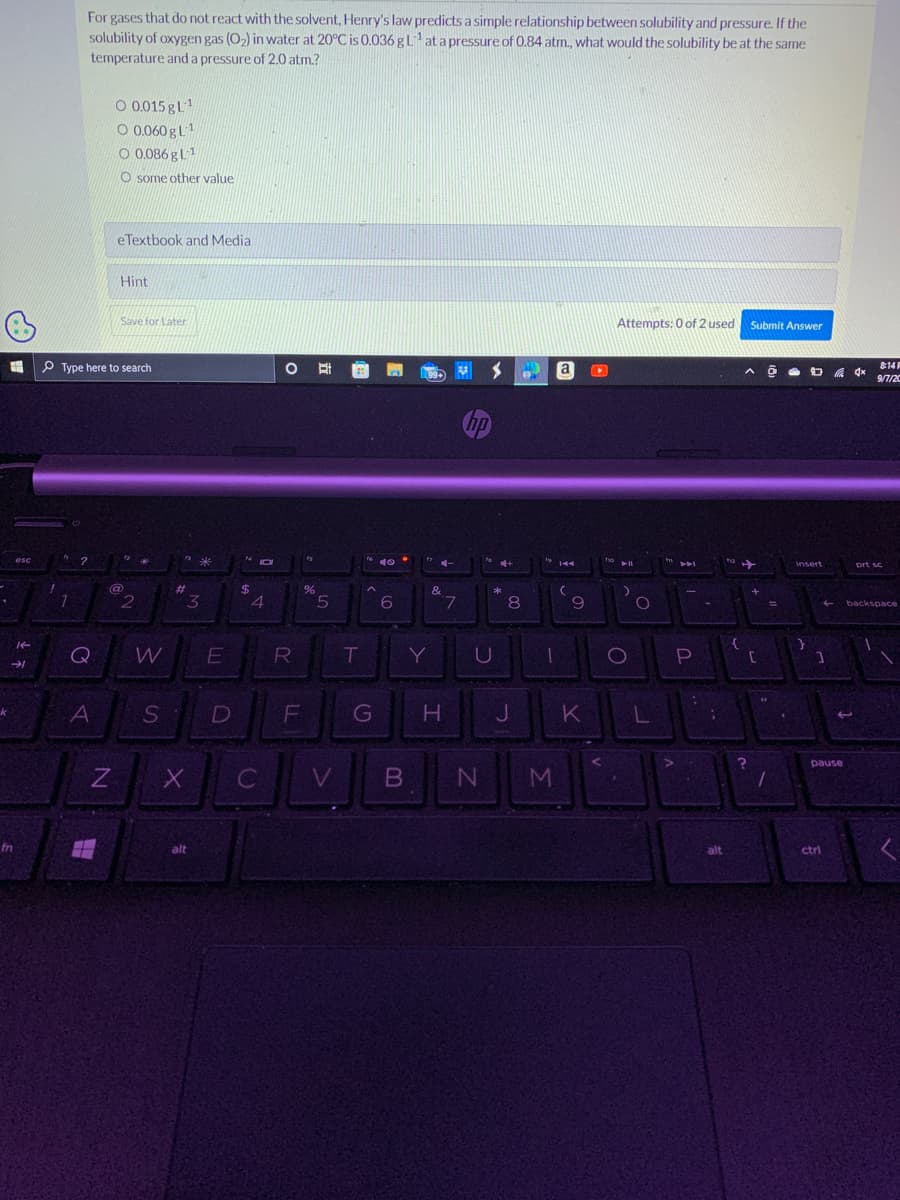For gases that do not react with the solvent, Henry's law predicts a simple relationship between solubility and pressure. If the solubility of oxygen gas (O₂) in water at 20°C is 0.036 g L¹ at a pressure of 0.84 atm., what would the solubility be at the same temperature and a pressure of 2.0 atm.? O 0.015 gL¹ O 0.060 g L¹ O 0.086 gL¹ O some other value
For gases that do not react with the solvent, Henry's law predicts a simple relationship between solubility and pressure. If the solubility of oxygen gas (O₂) in water at 20°C is 0.036 g L¹ at a pressure of 0.84 atm., what would the solubility be at the same temperature and a pressure of 2.0 atm.? O 0.015 gL¹ O 0.060 g L¹ O 0.086 gL¹ O some other value
Introductory Chemistry: An Active Learning Approach
6th Edition
ISBN:9781305079250
Author:Mark S. Cracolice, Ed Peters
Publisher:Mark S. Cracolice, Ed Peters
Chapter16: Solutions
Section: Chapter Questions
Problem 32E
Related questions
Question

Transcribed Image Text:k
esc
fn
14
→
For gases that do not react with the solvent, Henry's law predicts a simple relationship between solubility and pressure. If the
solubility of oxygen gas (O₂) in water at 20°C is 0.036 g L¹ at a pressure of 0.84 atm., what would the solubility be at the same
temperature and a pressure of 2.0 atm.?
1
2
Q
Type here to search
A
O 0.015 gl
O 0.060 g L1
O 0.086 g L¹
O some other value
eTextbook and Media
N
Hint
Save for Later
12
@
2
S
F
#
W E
X
3
alt
$
JOI
4
C
O
R
D F
ts
%
5
V
T
A
40 °
9
6
109. ✔
&
Y
G H
7
$
hp
B N
U
4+
*
8
00
J
0x
1
M
a
144
(
9
K
to
Attempts: 0 of 2 used Submit Answer
► 11
)
O
O
L
>
DI
P
:
S
alt
{
AD 4x
?
+
[
=
1
*
insert
}
1
ctrl
← backspace
↑
pause
814 F
9/7/20
prt sc
Expert Solution
This question has been solved!
Explore an expertly crafted, step-by-step solution for a thorough understanding of key concepts.
This is a popular solution!
Trending now
This is a popular solution!
Step by step
Solved in 3 steps

Knowledge Booster
Learn more about
Need a deep-dive on the concept behind this application? Look no further. Learn more about this topic, chemistry and related others by exploring similar questions and additional content below.Recommended textbooks for you

Introductory Chemistry: An Active Learning Approa…
Chemistry
ISBN:
9781305079250
Author:
Mark S. Cracolice, Ed Peters
Publisher:
Cengage Learning

Chemistry: Principles and Practice
Chemistry
ISBN:
9780534420123
Author:
Daniel L. Reger, Scott R. Goode, David W. Ball, Edward Mercer
Publisher:
Cengage Learning

General Chemistry - Standalone book (MindTap Cour…
Chemistry
ISBN:
9781305580343
Author:
Steven D. Gammon, Ebbing, Darrell Ebbing, Steven D., Darrell; Gammon, Darrell Ebbing; Steven D. Gammon, Darrell D.; Gammon, Ebbing; Steven D. Gammon; Darrell
Publisher:
Cengage Learning

Introductory Chemistry: An Active Learning Approa…
Chemistry
ISBN:
9781305079250
Author:
Mark S. Cracolice, Ed Peters
Publisher:
Cengage Learning

Chemistry: Principles and Practice
Chemistry
ISBN:
9780534420123
Author:
Daniel L. Reger, Scott R. Goode, David W. Ball, Edward Mercer
Publisher:
Cengage Learning

General Chemistry - Standalone book (MindTap Cour…
Chemistry
ISBN:
9781305580343
Author:
Steven D. Gammon, Ebbing, Darrell Ebbing, Steven D., Darrell; Gammon, Darrell Ebbing; Steven D. Gammon, Darrell D.; Gammon, Ebbing; Steven D. Gammon; Darrell
Publisher:
Cengage Learning

Chemistry & Chemical Reactivity
Chemistry
ISBN:
9781337399074
Author:
John C. Kotz, Paul M. Treichel, John Townsend, David Treichel
Publisher:
Cengage Learning

Chemistry & Chemical Reactivity
Chemistry
ISBN:
9781133949640
Author:
John C. Kotz, Paul M. Treichel, John Townsend, David Treichel
Publisher:
Cengage Learning

Chemistry: Principles and Reactions
Chemistry
ISBN:
9781305079373
Author:
William L. Masterton, Cecile N. Hurley
Publisher:
Cengage Learning